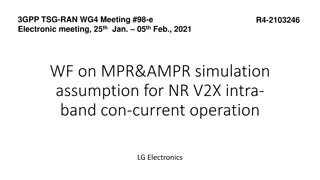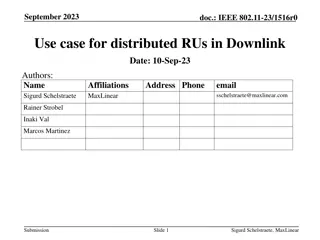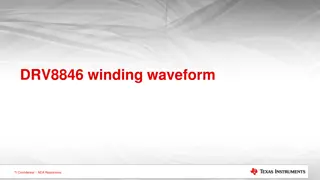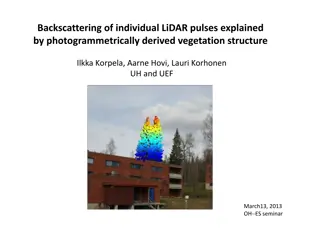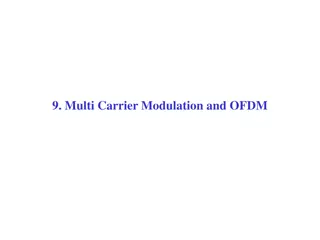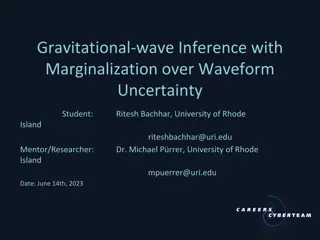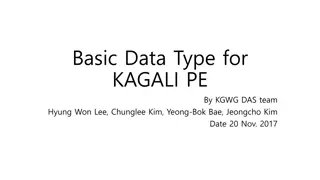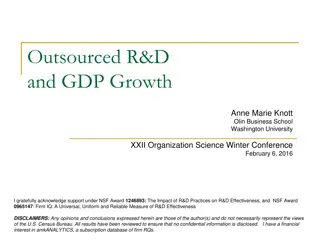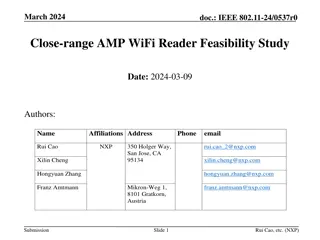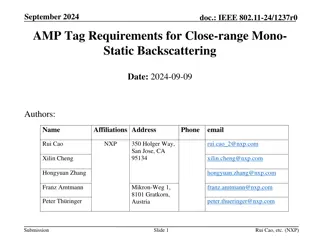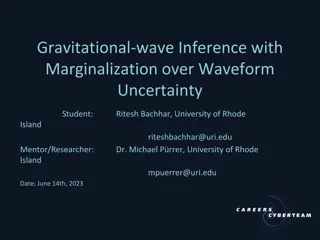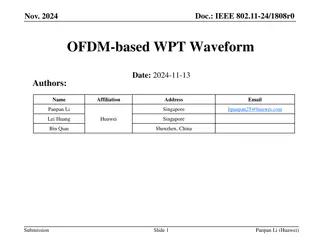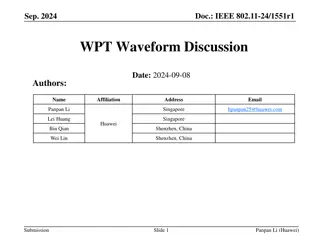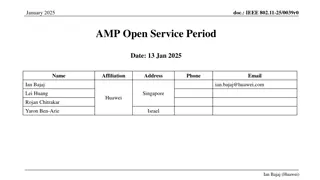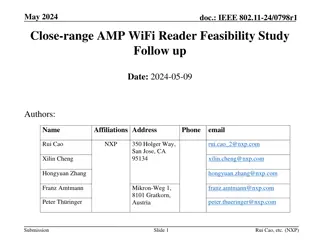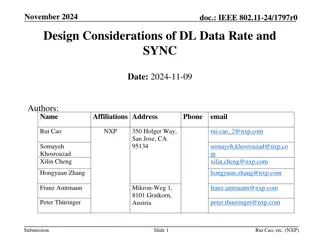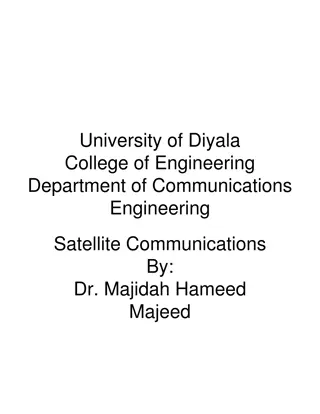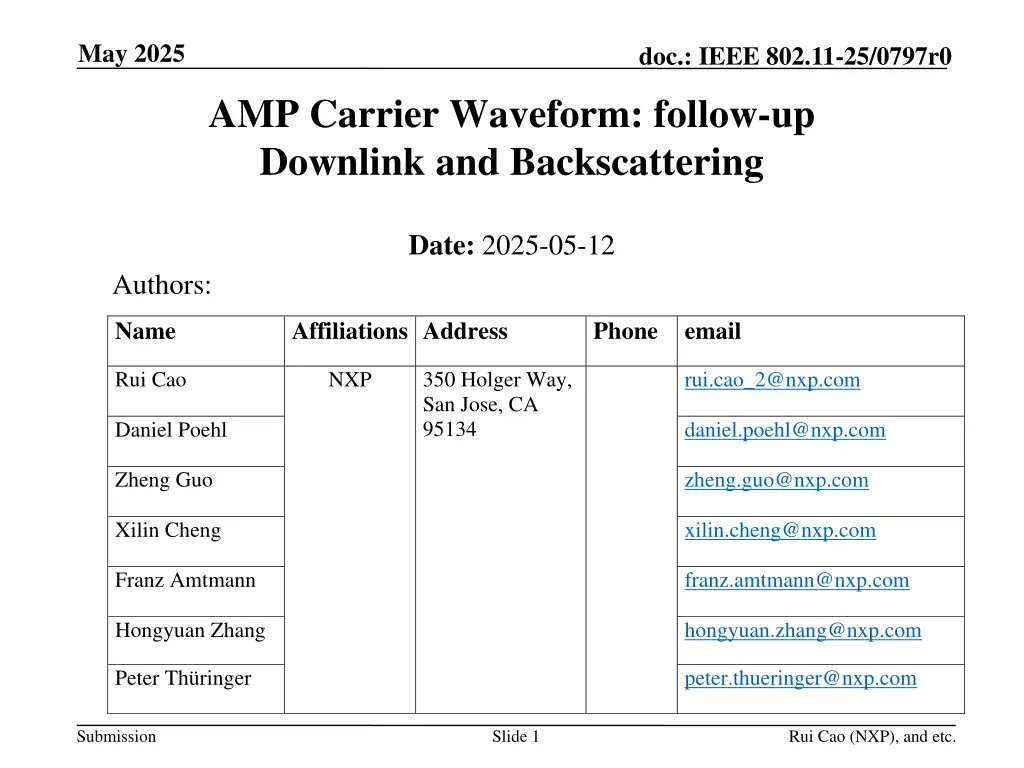
IEEE 802.11-25 Carrier Waveform Analysis and Optimization
Explore the analysis and optimization of the carrier waveform for IEEE 802.11-25, focusing on downlink, backscattering, and modulation aspects. The document delves into topics such as OFDM, symbol selection criteria, power variations, and modulation techniques. Discover insights and recommendations for enhancing performance and standardization in this specialized domain.
Download Presentation

Please find below an Image/Link to download the presentation.
The content on the website is provided AS IS for your information and personal use only. It may not be sold, licensed, or shared on other websites without obtaining consent from the author. If you encounter any issues during the download, it is possible that the publisher has removed the file from their server.
You are allowed to download the files provided on this website for personal or commercial use, subject to the condition that they are used lawfully. All files are the property of their respective owners.
The content on the website is provided AS IS for your information and personal use only. It may not be sold, licensed, or shared on other websites without obtaining consent from the author.
E N D
Presentation Transcript
May 2025 doc.: IEEE 802.11-25/0797r0 AMP Carrier Waveform: follow-up Downlink and Backscattering Date: 2025-05-12 Authors: Name Affiliations Address Phone email NXP Rui Cao 350 Holger Way, San Jose, CA 95134 rui.cao_2@nxp.com Daniel Poehl daniel.poehl@nxp.com Zheng Guo zheng.guo@nxp.com Xilin Cheng xilin.cheng@nxp.com Franz Amtmann franz.amtmann@nxp.com Hongyuan Zhang hongyuan.zhang@nxp.com Peter Th ringer peter.thueringer@nxp.com Submission Slide 1 Rui Cao (NXP), and etc.
May 2025 doc.: IEEE 802.11-25/0797r0 Introduction Carrier waveform is used for DL OOK modulation, UL backscattering modulation, tag excitation/energizer The performance of carrier waveform for backscattering PPDU is investigated [2] OFDM ~= DSSS L-LTF was analyzed as the OFDM carrier waveform March meeting motion: Carrier waveform is defined based on repeated base waveform with phase randomization Two further questions: How to standardize base waveform? How to design OFDM carrier waveform? Submission Slide 2 Rui Cao (NXP), and etc.
May 2025 doc.: IEEE 802.11-25/0797r0 Carrier Waveform Reader OFDM Preamble Excitation Excitation Payload SYNC UL SYNC Tag Payload Prefer OFDM symbol as base waveform Compatible with 802.11 OFDM preamble, already agreed in 11bp Reuse existing OFDM symbol definition, e.g. LTF, STF, etc. Easier reader implementation, no need to go through data path Avoid endless waveform optimization debates in WUR Challenging and do not expect much gain, considering tag ppm and random timing Prefer to standardize the carrier waveform in 11bp Tag design can optimize the envelope detector based on waveform Reader to optimize leakage cancellation, especially in bi-static case Easy interop, for certification definition Avoid the uncertainty and complexity for WUR waveform Slide 3 Submission Rui Cao (NXP), and etc.
May 2025 doc.: IEEE 802.11-25/0797r0 OFDM Carrier Symbol Selection Criteria Reader OFDM Preamble Excitation Excitation Payload SYNC UL SYNC Tag Payload Tx power: Spectrum close to random data low PAPR OOK ON waveform power variation DL modulated portion (SYNC, payload) and backscattering UL PPDU ON symbol power = Manchester bit detection SNR Manchester bits without FEC coding Random timing and high ppm at tag DL Rx detection and UL Tx OOK modulation Two rates: 2us ON (250kbps), 0.5us ON (1Mbps) Submission Slide 4 Rui Cao (NXP), and etc.
May 2025 doc.: IEEE 802.11-25/0797r0 ON Power Variation DL OOK: Reader can modulate on OFDM symbol boundary Tag Rx samples the waveform at random timing (2/4/8MHz) and ppm UL backscattering OOK: Tag modulates with random timing and ppm on OFDM waveform xdB variation will cause xdB reader performance loss Two rates: 250Kbps 2us ON and 1Mbps 0.5us ON Carrier Symbol DL 2us 2us 2us 2us UL 2us 2us 2us 2us us 0.5 us 0.5 us 0.5 us 0.5 0.5 us 0.5 us 0.5 us 0.5 us 0.5 us 0.5 us 0.5 us 0.5 us 0.5 us 0.5 us 0.5 us 0.5 us UL Submission Slide 5 Rui Cao (NXP), and etc.
May 2025 doc.: IEEE 802.11-25/0797r0 OFDM Carrier Symbol Candidates Carrier Symbol Bandwidth: 20MHz with existing tone plan Low-cost tag practically has no analogue filter, ~80MHz responsive. Higher Tx power Duration: 4us smaller OOK power variation Existing symbols with Low PAPR STF symbol: L-STF (0.8us), HE TB STF (1.6us) False trigger to WiFi devices or uncertain packet detection state machine. LTF symbol: L-LTF, VHT-LTF, HE-1xLTF Simple implementation. Preferred option. New symbol with QAM sequence Large search space with limited benefits Submission Slide 6 Rui Cao (NXP), and etc.
May 2025 doc.: IEEE 802.11-25/0797r0 AMP Reader Tx Architecture Up-sampling and Tx filter IFFT PA DAC OOK Modulation Tx filter will be able to suppress some spectrum growth due to OOK modulation PA distortion is symbol-content dependent Submission Slide 7 Rui Cao (NXP), and etc.
May 2025 doc.: IEEE 802.11-25/0797r0 ON Power: 250kbps (2us chip) Power swing (dB) Symbol HE_STF TB 0.2 HE_LTF_1x 0.6 LLTF 0.6 VHT_LTF 0.4 New Sequence [1] 0.5 All sequence has similar range: ~0.5dB Submission Slide 8 Rui Cao (NXP), and etc.
May 2025 doc.: IEEE 802.11-25/0797r0 ON Power: 1Mbps (0.5us chip) Power swing (dB) Symbol HE_STF TB 1.1 HE_LTF_1x 2.6 LLTF 2.1 VHT_LTF 1.6 New Sequence [1] 2.2 All sequence has similar range: ~2dB VHT_LTF is 0.5dB better Submission Slide 9 Rui Cao (NXP), and etc.
May 2025 doc.: IEEE 802.11-25/0797r0 Spectrum: Low Power RBW: 100kHz Submission Slide 10 Rui Cao (NXP), and etc.
May 2025 doc.: IEEE 802.11-25/0797r0 VHT-LTF, OOK, Low power RBW: 100kHz Submission Slide 11 Rui Cao (NXP), and etc.
May 2025 doc.: IEEE 802.11-25/0797r0 L-LTF, OOK, Low power RBW: 100kHz Submission Slide 12 Rui Cao (NXP), and etc.
May 2025 doc.: IEEE 802.11-25/0797r0 Spectrum: High Power RBW: 100kHz Submission Slide 13 Rui Cao (NXP), and etc.
May 2025 doc.: IEEE 802.11-25/0797r0 DL Spectrum: L-LTF, OOK, High power RBW: 100kHz Submission Slide 14 Rui Cao (NXP), and etc.
May 2025 doc.: IEEE 802.11-25/0797r0 DL Spectrum: VHT-LTF, OOK, High power RBW: 100kHz Submission Slide 15 Rui Cao (NXP), and etc.
May 2025 doc.: IEEE 802.11-25/0797r0 Summary The carrier base waveform needs to have good properties Support high Tx power Limited spectrum growth with OOK modulation Low OOK power variation: random offset and ppm Easy WiFi reader implementation Suggest to standardize the carrier base waveform using existing 20MHz 4us OFDM symbol L-LTF or VHT-LTF Submission Slide 16 Rui Cao (NXP), and etc.
May 2025 doc.: IEEE 802.11-25/0797r0 SP Do you agree to add the following to 11bp SFD? The SYNC, Data field and Excitation field of 11bp DL PPDU use OFDM symbol as base carrier waveform for OOK modulated communication. Submission Slide 17 Rui Cao (NXP), and etc.
May 2025 doc.: IEEE 802.11-25/0797r0 SP Do you agree to add the following to 11bp SFD? The base OFDM symbol is defined as 4us OFDM symbol, and generated by performing 64-point IFFT of the predefined sequence and pre-append the last 0.8us waveform as the cyclic prefix Submission Slide 18 Rui Cao (NXP), and etc.
May 2025 doc.: IEEE 802.11-25/0797r0 SP Do you agree to add the following to 11bp SFD? The frequency domain sequence for the base OFDM symbol is the same as the one defined for L-LTF Submission Slide 19 Rui Cao (NXP), and etc.
May 2025 doc.: IEEE 802.11-25/0797r0 Reference [1] 11-25/0325, Steve, amp-downlink-bandwidth-control- using-ofdm-spreading-waveform.pptx [2] 11-25-0305-00-00bp-AMP-Downlink-and- Backscattering-Carrier-Waveform Submission Slide 20 Rui Cao (NXP), and etc.
May 2025 doc.: IEEE 802.11-25/0797r0 Appendix Submission Slide 21 Rui Cao (NXP), and etc.
May 2025 doc.: IEEE 802.11-25/0797r0 Carrier Waveform Considerations Format uniformity for DL PPDU OFDM preamble OFDM carrier waveform DSSS preamble DSSS carrier waveform Mixed format is not preferred unless necessary: Easy to implement at WiFi Reader Repeated carrier waveform is preferred for OOK modulation in backscattering operation Easier for Tx implementation Automatically serve as reference symbol for leakage estimation Reference Symbol Reference Symbol Excitation Symbol Excitation symbol AMP Data AMP Data Submission Slide 22 Rui Cao (NXP), and etc.
May 2025 doc.: IEEE 802.11-25/0797r0 Carrier Waveform Considerations Low PAPR waveform candidates Single-tone CW: Tx power limitation in some regions >10MHz BW was agreed DSSS waveform Single carrier waveform, 2~3dB OFDM waveform STF symbol (~2dB): may cause legacy WiFi devices to false detect LTF symbol (~3dB): preferred Newly optimized symbol: flexible BW, non-BPSK signal Added complexity with limited benefits Submission Slide 23 Rui Cao (NXP), and etc.
May 2025 doc.: IEEE 802.11-25/0797r0 L-LTF OOK 2us 2us 2us 2us 2us 0.5 us 0.5 us 0.5 us 0.5 us 0.5 us 0.5 us 0.5 us 0.5 us 0.5 us 0.5 us 0.5 us 0.5 us 0.5 us 0.5 us 0.5 us 0.5 us 0.5 us 0.5 us 0.5 us 0.5 us Submission Slide 24 Rui Cao (NXP), and etc.
May 2025 doc.: IEEE 802.11-25/0797r0 High Power Submission Slide 25 Rui Cao (NXP), and etc.
May 2025 doc.: IEEE 802.11-25/0797r0 Low Power Submission Slide 26 Rui Cao (NXP), and etc.
May 2025 doc.: IEEE 802.11-25/0797r0 Tx Power Gain over New Sequence [1] 0.77 0.69 0.32 0.49 VHT-LTF, 1Mbps VHT-LTF, 250kbps L-LTF, 1Mbps L-LTF, 250kbps Submission Slide 27 Rui Cao (NXP), and etc.

